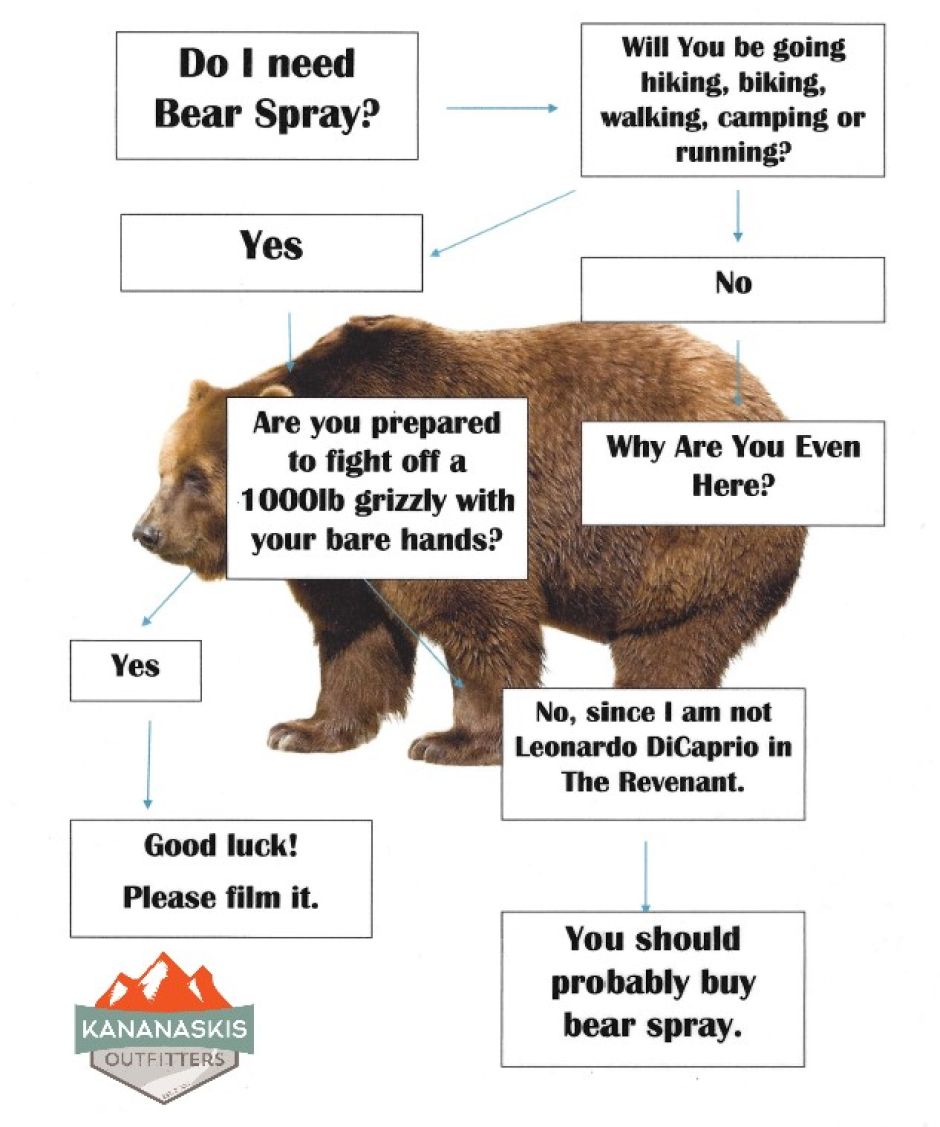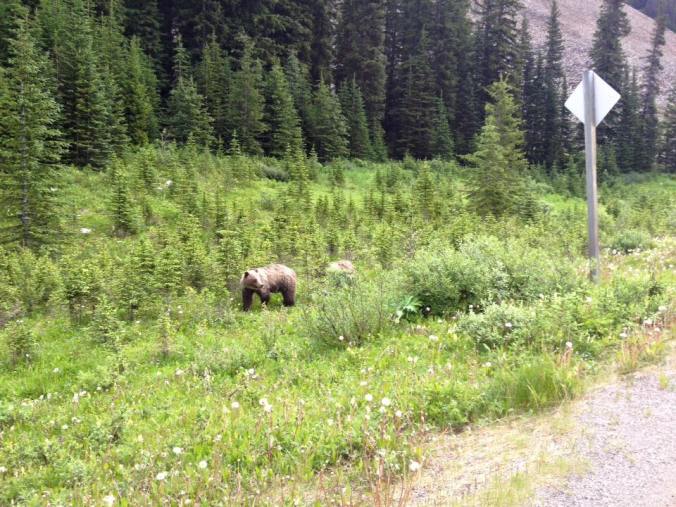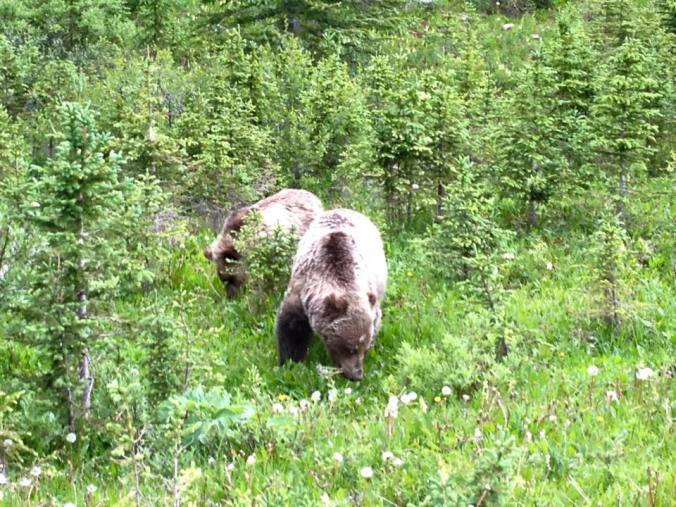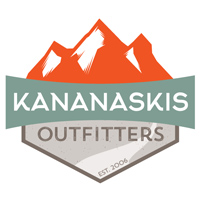Visiting Bear Country
Bears are a hot topic in Kananaskis. We frequently get asked by visitors to the area if there are bears here, and once told that there are in fact bears here (grizzly and black!), the follow-up question is usually ‘Well do I need bear spray?’

The follow-up question is usually ‘But are there actually bears?’ Yes. There are actually bears in the Kananaskis area. Bears can be found everywhere in the Rockies, to be precise. Should you live in fear of bears? Heck no! There is no point in being afraid of bears, what everyone really needs is to be educated about bears, and bear safety. Carry bear spray and know how to use it. When you are buying it, the place selling it should give you a full demo on how to use it. If not, ask someone who is familiar with it. Knowing how to use bear spray is vital to feeling comfortable carrying it, and therefore comfortable in bear country.
-
Top things to remember in Bear Country:
-
- Do not leave food/attractants laying around. This includes things like soap, shampoo, petroleum products, alcohol, packaged food, pet food, etc.
- Do not feed ANY wildlife. Those cute squirrels or chipmunks that take food from your hand? They’re not eating all of it, they are caching it. That means they are burying it around your campsite or picnic area. Buried food attracts bears.
- Do not approach bears intentionally; do not try to pet them, ride them or feed them.
- Make noise when you hike, this way you won’t surprise wildlife on the trail. Most animals really don’t want to see us, we just surprise them when we move quietly through the woods and they are bound to react defensively. Think about times when someone jumped out at you.
- Give wildlife its space, especially bears. It’s better to have to backtrack on a trail than to risk it and skirt too close to a bear.
Should you be afraid of being in bear country? No! Should you be respectful towards and educated about bears and bear safety? Yes! It is quite common for hikers to see a bear while out and about in the Kananaskis area. Typically the bear will move off, not wanting anything to do with people.
-
Things you probably didn’t know about bears:
-
- Bears are not true hibernators. They go into something called torpor, where they can wake up if disturbed or if weather conditions change.
- Female bears give birth in January/February to cubs the size of a pound of butter.
- Bears will occasionally make ‘nests’. They will climb a tree and pick branches to eat the fresh shoots on the end and then they will drop the branches and they will collect in the tree, creating what appears to be a very large nest.
Bears are beautiful animals; here are some of our locals:








On photographing bears (and other wildlife)
Everyone wants that amazing and perfect close-up of a bear in the wild, but is that photo worth your life? Or a bears? A bear that becomes overly comfortable with humans, or with humans feeding it, is almost guaranteed to end up dead at the hands of humans, either having to be put down because it sees humans as a food source, or dead due to road mortality because it doesn’t see cars as a threat, or people are driving unsafely around it.
Over the years, working for Parks and now as a guide in the Rockies, I have seen some seriously crazy stuff. People need to realize that wildlife is…wild. You can’t walk up a wild animal like it’s a neighborhood dog. And sure, maybe the person before you did it, and they were fine. Maybe you can do it too, this one time. But it’s always okay, right until it isn’t. Then the next thing you know, there is a story on the news of a ‘bear attack’ and everyone calls it a tragic accident.
The truth is, most negative wildlife encounters are completely avoidable. Respecting an animals personal space and making noise so as not to surprise them will help stop most negative encounters.
Here are some ‘Best Practices’ for photographing or viewing wildlife.
1. Stay in your vehicle.
If you are driving and you see an animal roadside, then it’s simple: Stay in your vehicle. Things start to go wrong when people start to view the wildlife as tame animals. Just because the bear is on the side of the road, and seems more interested in food than you, does not make it okay to get out and approach it.
2. Do not cause a bear jam.
Or a deer jam, or a squirrel jam, or any sort of traffic jam for whatever it is that you see. If you see wildlife, and you are going to stop for a better look, then pull over on the shoulder of the road as far as you safely can. If you cannot safely pull over and get off the road, then you don’t stop.
3. Do not harass the wildlife.
Do not stay by an animal for more than a minute or two (refer to #2). The bears do not enjoy having vehicles stop by them and stay there for an extended period of time. If you are going to stop and can safely do so, then stop for a minute or two, snap your photos, admire the animal and be on your way. We do not want animals to become accustomed to humans because in the long term, that is how they end up dead.
4. Do not bait the wildlife.
On this point, most people are probably thinking ‘Well obviously!’ But a lot of people are unintentionally ‘baiting’ wildlife through simple carelessness. Do you know how many common camping items are actually considered bear or wildlife attractants? Things like: toothpaste, shampoo, soap, cooking oil, canned goods, alcohol, freeze-dried foods, pet foods, dirty dishes, the clothes you cooked/ate in, etc. By leaving these things out and unattended in day-use areas or campsites, you are inviting wildlife into your site. A fed bear is a dead bear. And no photo is worth a bear’s life.
5. Do not feed the wildlife.
Any of it. Not even that cute squirrel or bird. Have you ever fed a squirrel or chipmunk and noticed that they are taking a lot of food? Like more than their own body weight in food? They are not eating it all, they are cacheing it around your site, creating little hidden treasures of food that will attract other animals to the area.
6. Do not touch the wildlife.
By now, everyone has probably heard about the well-meaning tourist in Yellowstone who picked up the bison calf because he ‘thought it looked cold.’ Do not assume that baby animals who appear to be left alone, are abandoned. Mothers in nature know what’s best for their young and it is not our job to interfere. Do not pick up wild animals, if you are concerned that something has been abandoned, or is injured, report it to your local conservation officers, park staff, or fish and wildlife officers. You can find these numbers online for your local area.
7. Use a long lens.
Do not expect to get a great close-up photo with your smartphone. Please don’t even try to do it. Use a zoom lens, or take the photo and crop it down after. Approaching wildlife with a smartphone to get a close-up photo is a sure way to get hurt.
So what do you do if you come across a bear on the trail or on the roadside? You should call it into your local wildlife hotline. Google to find your local wildlife authority or parks service. If you call in a report, you are going to be asked for some basic info. Here are some things that you will probably be asked:
- Your name and contact number
- Type of Bear (black or grizzly, remember not all black bears are black!)
- Location – try to get as many landmarks as possible, signs, intersections, etc
- What the bear was doing
- How long ago you saw it
- If the bear was eating, what it was eating.
- How close you were to the bear
- How it reacted (surprised, aggressive, indifferent, curious, etc)
- Visible tags or collars (note numbers on tags and color of tag if possible)
- If there were cubs, how many?
- If it was roadside, were other people stopped/getting out of vehicles
This information is used for biologists to track bears and behavior and also used to dispatch conservation officers to help move bears along and stop human-bear conflicts. If you see a conservation officer or parks employee on the scene, then do not report it. The person on scene is there because someone else has reported it/they are already aware of the situation so you do not need to create duplicate calls.
People visit the mountains because they want to enjoy the landscape and the wildlife, so if everybody would do their part to be here and respect nature then we can ensure that these places are here and protected forever and that future generations will get to see these magnificent animals in their natural habitat.
When you live out here, you see some of the same bears on a pretty regular basis; you honestly start to love them and love seeing them. You get to watch cubs grow up, bears flirting during mating season, and bears fattening up during the fall. You eagerly await seeing the first bear of spring, since that means spring is really here.
What I want people to take away from this is that bears are incredible creatures that have a place here. This is their home that we are visiting and if we all follow some basic guidelines, we can live and play in bear country without being afraid.
Stay up to date with current Alberta Parks advisories here.
Latest Stories
Summer Tours
Winter Tours
Like this article? Share!
